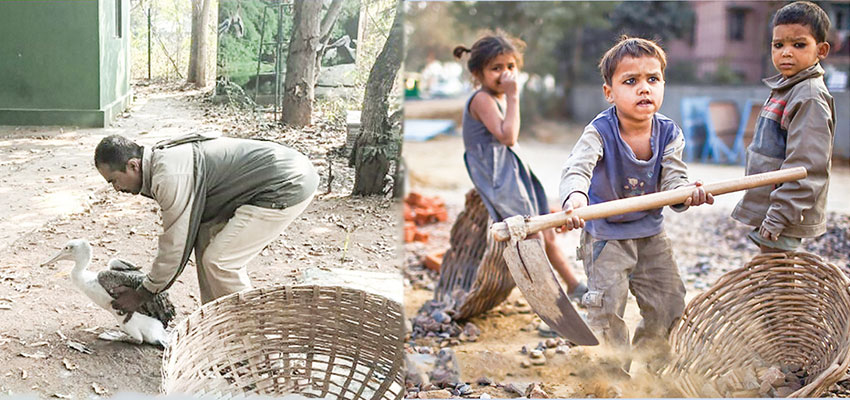
"Corporate Citizen claps for the villagers of Kokkarebellur, a small Karnataka hamlet that has become an annual resting ground for the innumerable International Union for Conservation of Nature (IUCN) Red listed migratory Painted Storks and Spot-Billed Pelicans."
It exemplifies a perfect example of human-animal co-existence. Kokkarebellur (Kokrebellur), located 90 km SouthWest of Bangalore in Karnataka’s Mandya district (Maddur taluka), welcomes hundreds of spot-billed pelicans (Pelecanus philippensis) and the painted storks every year. The birds pair up, build nests, lay eggs and raise their chicks in the village precincts. The global pelican population is estimated to be below 20,000, and the breeding population of the species is confined to India, Sri Lanka, Cambodia and potentially Thailand, as per a 2006 estimate. Kokkarebellur, despite its population below 1500, rely on the villagers who vigilantly check on the migratory birds and rescue them if needed. The villagers, surprisingly, do not mind the strong stench of bird droppings and even children watch over the birds. “If the chicks fall on the net (hung below the trees, minimising the impact of the fall), my son picks them up and wants to nurse them back to health. We, however, hand them over to the forest watcher for further care,” said Shobha, a villager. Then there is B. Lingegowda, the only remaining active member of the now defunct Hejjarle Balaga (Friends of the Pelican), a youth group. He has pledged 2,500 sq. ft. of his land and established a nursery for rescued and injured birds in 1994. Aksheeta Mahapatra, a Ph.D scholar from the Wildlife Institute of India, has recorded an average of 500 spot-billed pelicans and 2,000 painted storks visiting Kokkarebellur annually. “In 2023, 400 pelicans and 2,000 storks flew into the village while 2022 saw 300 pelicans and 1,500 storks”, she said. According to Lokesh P, the forest watcher, “I have counted 90 nests; 180 birds have arrived. They will keep coming till February.” He last recorded around 1,000 painted storks in Kokkarebellur. With no concerted effort to study the population or the bird’s breeding status and distribution in recent times, the combined efforts at the Kokkarebellur Community Reserve is indeed a significant step to save the threatened migratory bird pool.
"Corporate Citizen slaps the now well- entrenched child labour market, that sees no end even after 75 years of constitutional guarantees under Article 24, prohibiting hazardous child labour."
It has been twenty years since the Right to Education beckoned all children up to 14 years to educate themselves; but innumerable unfortunate children continue to be denied their fundamental rights. We continue to witness the growing numbers of child labour despite legislation. Moreover, the government’s agenda to eliminate child labour in all its forms by 2025 seems like a time bomb ticking under the government’s Sustainable Development Goals (SDGs). With two years to accomplish the impossible feat, Supreme Court lawyer, and child rights activist, Bhuwan Ribhu, brings forth the issues ailing societal and constitutional loopholes that prevent children from exercising their fundamental rights. He writes, “The country has been witnessing a changing landscape for children in the last three decades, including the criminalisation of child labour and the creation of ecosystems where child labour doesn’t thrive, but the situation continues to be grim.” The irony however lies in the definition of a child. According to the Child and Adolescent Labour (Prohibition and Regulation) Act, 1986 (CALPRA), a ‘child’ means a person who has not completed his 14th year of age or such age as may be specified in the Right of Children to Free and Compulsory Education Act, 2009, whichever is more. It would mean any child on the cusp of their 13th or 14th year would qualify if at all to be inducted as a wage earner despite the constitution stating RTE for all children up to age 14. The ambiguity was observed and tabled in the 52nd report of the Parliamentary Standing Committee on Labour, Textiles And Skill Development Committee. However, an amendment made to the Act in 2016 defines the child as someone in the 14-18 years’ age group. The ‘adolescent’ state is not defined in the Juvenile Justice Act, of 2015. The Rashtriya Kishore Swasthya Karyakaram under the Ministry of Health and Family Welfare defines an adolescent as a person between 10-19 years. The Ministry of Labour and Employment is expected to build a zero-tolerance protocol on child labour soon. Isn't it high time that the 'child' gets uniformity by definition and judiciary compassion- SDGs or Not?